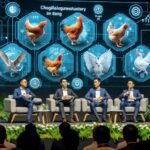The poultry industry is witnessing an unprecedented transformation, driven by technological advancements that promise to redefine farming practices. From artificial intelligence (AI) to the Internet of Things (IoT) and data-driven decision-making, these innovations are not just trends—they are necessities for staying competitive and sustainable.
The keynote address on technology in poultry farming highlighted the potential of these tools to reshape the future of the industry. This blog delves deeper into how adopting technology can help poultry farmers overcome challenges and unlock new opportunities for growth.
The Role of Technology in Modern Poultry Farming
As global demand for poultry products rises, farmers face increasing pressure to improve efficiency, reduce costs, and maintain high standards of quality and safety. Technology provides the tools to achieve these goals, enabling smarter, more precise, and sustainable farming practices. AI-powered analytics, IoT-enabled monitoring systems, and integrated management platforms are transforming how farms operate, allowing farmers to make informed decisions and optimize performance.
Artificial Intelligence: Transforming Decision-Making
AI is a game-changer in poultry farming, offering predictive insights and automation capabilities that simplify complex processes. From predicting disease outbreaks based on environmental conditions to optimizing feed conversion ratios, AI empowers farmers with actionable data. These tools help reduce losses, improve flock health, and maximize profitability.
IoT: Real-Time Monitoring and Control
IoT devices are revolutionizing poultry farming by providing real-time monitoring and control over critical parameters. Smart sensors track environmental factors like temperature, humidity, and air quality, ensuring optimal conditions for birds. Farmers receive instant alerts for deviations, enabling quick interventions that prevent losses and ensure consistent productivity.
Data-Driven Solutions: Enhancing Efficiency
Data is the backbone of modern poultry farming. Advanced management systems collect and analyze data across operations, providing valuable insights into performance metrics. Whether it’s tracking feed consumption, monitoring growth rates, or analyzing financial trends, data-driven solutions enable farmers to identify inefficiencies and implement corrective measures.
Overcoming Challenges with Technology
Despite the clear benefits, adopting technology in poultry farming is not without challenges. Initial costs, lack of awareness, and the need for technical expertise can deter farmers. However, organizations like the PoultryTech Innovation Council (PTIC) are bridging the gap by offering training, resources, and accessible solutions that cater to farms of all scales.
The Economic and Environmental Impact
Beyond operational efficiency, technology adoption has significant economic and environmental benefits. Automated systems reduce labor costs, optimized feeding minimizes waste, and real-time monitoring prevents resource overuse. These practices not only boost profitability but also align with sustainability goals, meeting the expectations of environmentally conscious consumers.
Conclusion
The keynote address emphasized the need for the poultry industry to embrace technology as a fundamental driver of growth and sustainability. Farmers, policymakers, and industry stakeholders must collaborate to create an ecosystem that supports innovation and adoption. Investing in technology today is an investment in the future of poultry farming.






